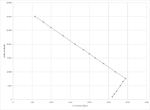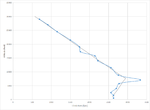I'm looking at the Hawker Hurricane Mk.I, just the prototype and I've noticed something unusual
Altitude.....Time to Climb.....Time to Climb Interval.....Listed Rate of Climb.....Calculated Rate of Climb
0'..............0 .....min..............0......min..........................2550 fpm.......................N/A
1000'........0.38 min..............0.38 min..........................2600 fpm.......................2632 fpm
2000'........0.76 min..............0.38 min..........................2650 fpm.......................2632 fpm
3000'........1.15 min..............0.39 min..........................2710 fpm.......................2564 fpm
5000'........1.89 min..............0.74 min..........................2810 fpm.......................2703 fpm
6500'........2.43 min..............0.54 min..........................2880 fpm.......................2778 fpm
7600'........2.76 min..............0.33 min..........................2950 fpm.......................3333 fpm
10000'......3.63 min..............0.87 min..........................2680 fpm.......................2759 fpm
13000'......4.8...min..............1.17 min..........................2370 fpm.......................2564 fpm
15000'......5.7...min..............0.9...min..........................2150 fpm.......................2222 fpm
16500'......6.4...min..............0.7...min..........................2000 fpm.......................2143 fpm
18000'......7.25 min..............0.85 min..........................1840 fpm.......................1765 fpm
20000'......8.4...min..............1.15 min..........................1620 fpm.......................1739 fpm
23000'......10.4 min..............2......min..........................1310 fpm.......................1500 fpm
26000'......13.0 min..............2.6...min............................990 fpm.......................1154 fpm
28000'......15.2 min..............2.2...min............................790 fpm.......................909...fpm
30000'......18.1 min..............2.9...min............................570 fpm.......................690...fpm
Why are there these discrepancies?
Altitude.....Time to Climb.....Time to Climb Interval.....Listed Rate of Climb.....Calculated Rate of Climb
0'..............0 .....min..............0......min..........................2550 fpm.......................N/A
1000'........0.38 min..............0.38 min..........................2600 fpm.......................2632 fpm
2000'........0.76 min..............0.38 min..........................2650 fpm.......................2632 fpm
3000'........1.15 min..............0.39 min..........................2710 fpm.......................2564 fpm
5000'........1.89 min..............0.74 min..........................2810 fpm.......................2703 fpm
6500'........2.43 min..............0.54 min..........................2880 fpm.......................2778 fpm
7600'........2.76 min..............0.33 min..........................2950 fpm.......................3333 fpm
10000'......3.63 min..............0.87 min..........................2680 fpm.......................2759 fpm
13000'......4.8...min..............1.17 min..........................2370 fpm.......................2564 fpm
15000'......5.7...min..............0.9...min..........................2150 fpm.......................2222 fpm
16500'......6.4...min..............0.7...min..........................2000 fpm.......................2143 fpm
18000'......7.25 min..............0.85 min..........................1840 fpm.......................1765 fpm
20000'......8.4...min..............1.15 min..........................1620 fpm.......................1739 fpm
23000'......10.4 min..............2......min..........................1310 fpm.......................1500 fpm
26000'......13.0 min..............2.6...min............................990 fpm.......................1154 fpm
28000'......15.2 min..............2.2...min............................790 fpm.......................909...fpm
30000'......18.1 min..............2.9...min............................570 fpm.......................690...fpm
Why are there these discrepancies?


